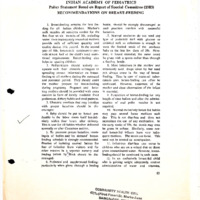Resources
Item
- Title
- Resources
- extracted text
-
SDA-RF-CH-1.6
iniian VI SiAlRI^ s
VOLUME 21—JANUARY 1984
INDIAN ACADEMY OF PEDIATRICS
Policy Statement Based on Report of Special Committee (1983)
RECOMMENDATIONS ON BREAST-FEEDING
1. Breast-feeding remains the best fee bottle, should he strongly discouraged as
ding for all Indian children. Mother’s such practices interfere with successful
milk supplies all nutrients needed for the lactation.
J. Normal newborns do not need any
first four to six months of life, including
water. Even inadequately nourished mothers type of prelacteal feed with glucose or
provide milk of sufficient quantity and artificial milk as colostrum is enough to
quality during this period. In the second meet the limited needs of the newborn
year of life, breast-milk continues to pro baby in the first few days of life. How
vide atinost half of the child’s total nutri ever, if found essential, the same could
tional requirements. Breast-feeding also be given with a spoon rather than through
helps in spacing children.
a feeding bottle.
2. Pediatricians should actively co.8. Most infections in the mother and
operate with their obstetric colleagues in commonly used drugs taken by her need
spreading correct information on breast not always come in the way of breast
feeding to all mothers during the antenatal feeding. Thus in case of maternal tuber
and postnatal period. They should assist culosis also, breast-feeding can often be
the mother prepare for breast-feeding continued. However, treatment of the
during pregnancy. Pregnant and lacta mother and close observation of the infant
ting mothers should be provided with extra is essential.
calories in form of locally available food
9. Restriction of breast-feeding for any
preferences, dietary habits and meal patterns. length of time before and after the admini
3. Obstetric practices that may interfere stration of oral polio vaccine is not
with proper lactation should be dis required.
couraged.
10. Normal exclusively breast-fed babies
4. Baby should be put to breast pre may pass several loose motions each
ferably in the labor room itself but defi day. This is not diarrhea and does not
nitely within four hours after delivery. necessitate the use of any medication. In
This is true for all babies whether delivered the early weeks of life, the stools may even
normally or after Caesarean section.
be green in colour. Similarly, some nor
5. To promote proper lactation, room mal breast-fed infants have very infre
ing-in of babies and ‘on demand’ breast quent motions. The stools are loose. This
feeding schedule is strongly recommended. need not be treated as constipation.
Practice of isolating normal babies for
11. Infectious diarrhea can occur in
fear of infection from visitors and for children who are on a mixed diet or those
other reasons in a separate nursery and given contaminated water. However, breast
feeding babies by " clock should be dis feeding should be continued in such cases.
couraged.
12. In an exclusively breast-fed child
6. Prelacteal and supplemental feeding- who is gaining weight adequately, routine
particularly when given through a feeding administration of water and vitamins,
83
RECOMMENDATIONS ON BREAST'IEEDING
and addition of outside milk, weaning cereals). These foods should be started bet
foods, juices and soups is not needed until ween 4-6 months, preferably at 6 months in
the age of six months as early addition of infants who are thriving well at the breast.
such items interfere with proper lactation Breast-milk is continued along with
and increase the risk of diarrhea and aller solids.
gic disorders like eczema and bronchial
15. Pediatricians should follow in enti
asthma.
rety the ‘Indian National Code for Protec
13. A baby demands feeds frequently; tion Promotion of Breast-feeding’ in its letter
especially in the first few days after delivery. and spirit. Thus (a) hospitals, nursing homes
This is physiological and should not be and'doctor’s place of work should not be
taken as a sign of inadequate breast-milk. allowed to be used for the display of infant
Crying in a baby is mostly due to colic and foods, feeding bottles and teats, (b) pedi
not necessarily due to inadequate milk.
atricians should refuse all types of induce
14. A continuous effort should be made ments from the manufacturers and distri
by all pediatricians to encourage freshly butors of these products and (c) employees
made, locally available family foods to of such manufacturers and distributors
be used as weaning foods as they work out should not be allowed direct or indirect ,^
to be far better, cheaper and beneficial contact of any kriid with pregnant women
than the marketed weaning foods (e.g. or with mothers of infants and young
porridge made with locally available children.
84
- Media
 SDA-RF-CH-1.6.pdf
SDA-RF-CH-1.6.pdf
Position: 2904 (3 views)
